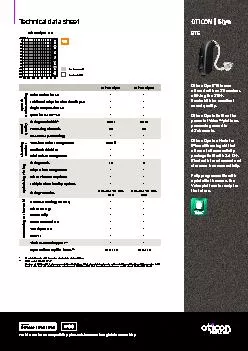PDF-Instructions for useIICCICITCOticon OpnOticon Siya
Author : anderson | Published Date : 2021-08-26
Model overviewThis booklet is valid for the Oticon Opn153 and Oticon Siya families in the following hearing aid models battery sizes and styles Oticon Opn 1 Oticon
Presentation Embed Code
Download Presentation
Download Presentation The PPT/PDF document "Instructions for useIICCICITCOticon OpnO..." is the property of its rightful owner. Permission is granted to download and print the materials on this website for personal, non-commercial use only, and to display it on your personal computer provided you do not modify the materials and that you retain all copyright notices contained in the materials. By downloading content from our website, you accept the terms of this agreement.
Instructions for useIICCICITCOticon OpnOticon Siya: Transcript
Download Rules Of Document
"Instructions for useIICCICITCOticon OpnOticon Siya"The content belongs to its owner. You may download and print it for personal use, without modification, and keep all copyright notices. By downloading, you agree to these terms.
Related Documents










